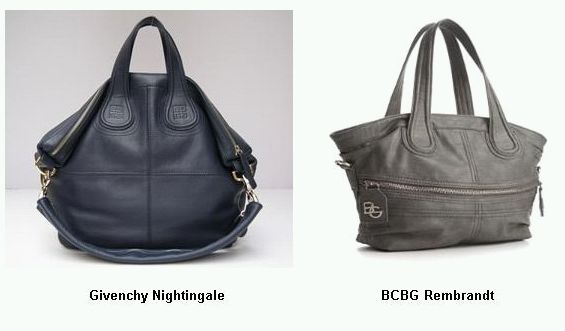Givenchy's Nightingale handbag is a favorite among celebrities and handbag lovers everywhere. According to French couture house Givenchy S.A., BCBG Max Azria Group, Inc. thought so too and, wanting to make a profit off the Nightingale handbag, began manufacturing alleged knockoffs of the popular bag. Givenchy quickly filed suit against BCBG alleging violations of trade dress and unfair competition laws. Here are some pictures of Givenchy's Nightingale handbag next to BCBG's Rembrandt handbag.


Recently, BCBG filed a motion for summary judgment in the case asking the Court to make an early decision in the case that BCBG is not infringing. While there are issues concerning functionality and secondary meaning, the most interesting issue focuses on likelihood of confusion. Since BCBG has stopped selling the allegedly infringing handbags, Givenchy argues that post-sale confusion comes into play here because a consumer who sees the handbag on the street would mistakenly believe that it was a Nightingale handbag. Under trademark law, post-sale confusion focuses on confusion on the part of someone other than the purchaser who sees the item and confuses it with another, similar product.
BCBG argues that consumers are unlikely to be deceived into believing that Givenchy is the source of its Rembrandt and Lulu handbags because of numerous differences between the handbags. These differences include the prices of the handbags (around $100 for the Rembrandt and Lulu handbag compared to $1,600-4,000 for the Nightingale handbag), the material of the handbag (fine leather vs. plastic (PVC)), the zipper detail on BCBG's handbags, and the fact that the handbags were sold in different stores. BCBG also argues that the silhouettes of the handbags are different since the corners of the Nightingale handbag droop downward (which, according to BCBG, gives the handbag the appearance of a bowling ball bag).
Even though there are differences between the bags, the question is whether consumers seeing someone carrying the bag will identify Givenchy as the source of the handbag. When looking at the issue from this point of view, the differences pointed out by BCBG don't seem as important. The U.S. District Court for the Central District of California is considering BCBG's motion and I am continuing to follow this interesting case.
www.cozen.comThe content of this article is intended to provide a general guide to the subject matter. Specialist advice should be sought about your specific circumstances.


